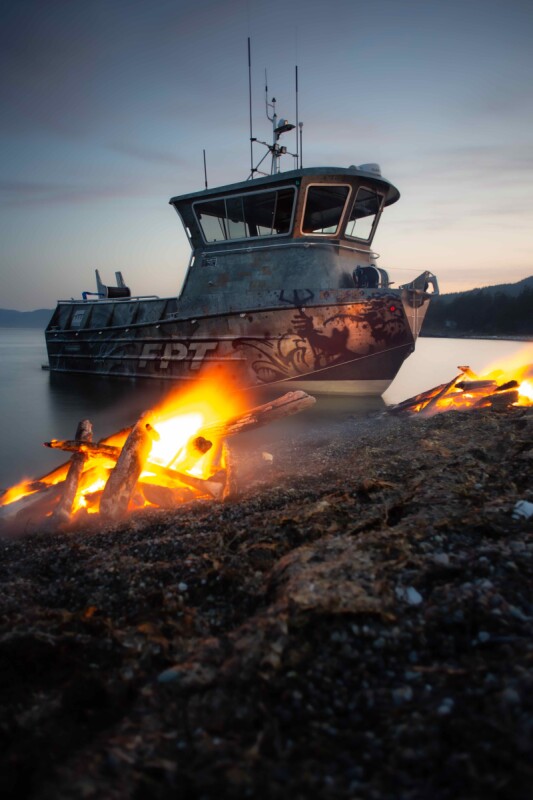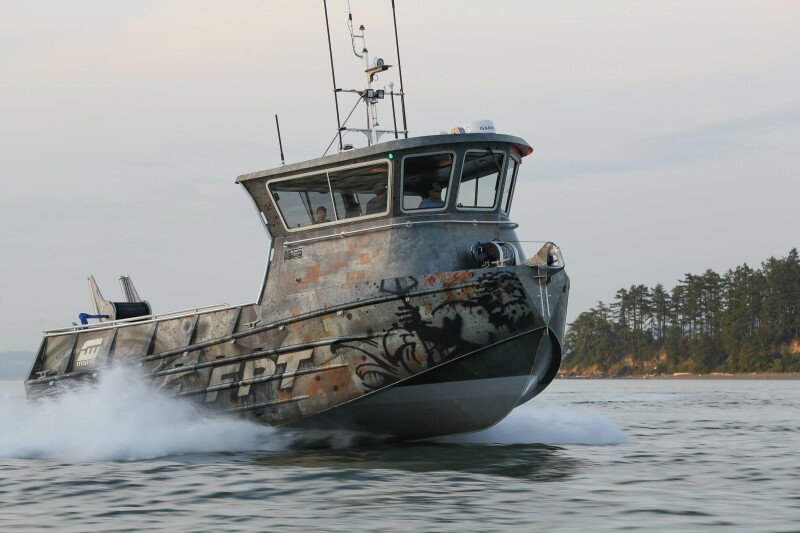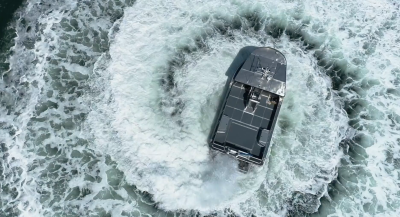Boatbuilders create energy with imagery, bringing a different kind of excitement to Bristol Bay
When Derick Burns took the vinyl-wrapped gillnetter, Killer, to Bristol Bay in the summer of 2021, he didn’t know what to expect.
“I got a lot of comments. I felt like I was like in a movie,” says Burns. “Boats coming by, and people were taking pictures.” The Killer had been wrapped in a printed vinyl covering that made it look like a giant salmon emblazoned with the FPT logo – a novel way to promote FPT engines in the absence of trade shows during the pandemic.
The pandemic may be over, but the idea of wrapping boats has stuck, and Burns is taking another wrapped boat—the Battleship—to Bristol Bay for the 2023 season. The concept for the Battleship wrap came from Justin Roeser at MSHS. Tom Aliotti built the boat in Bellingham, Washington, and Troy Dorn, who did the wrap install on the Killer, also did the install on the Battleship.
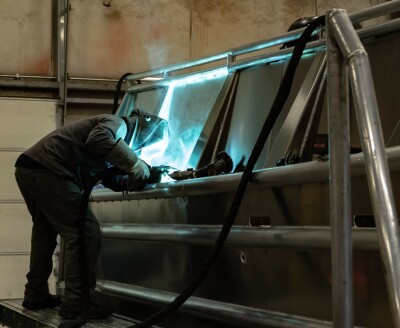
“The idea is kind of apocalyptic,” says Roeser. “The survival of the fittest, and the boat is supposed to look like it’s made it through a war.” Roeser believes the new wrap will sell engines better than the first, and that’s good news for builder Tom Aliotti, who handles FPT sales on the West Coast.
“The more we sell the better we can support them up in Alaska,” says Aliotti. “So far, between the ones I’ve put in my boats and the ones I’ve sold, I’ve got around 60 engines out there.” But for Aliotti, what’s under the wrap is what’s important. “We have tweaked the hull design,” he says. “But I can’t tell you how.”
His signature hull design is under wraps in more ways than one. The rest is open for all to see—the wrap even has a picture of a hole in the side of the boat, giving an imagined look at the two 530-hp FPT550 engines in the Battleship. “I think for power to-weight ratio, and being problem-free, FPT is the best,” says Aliotti. “We haven’t had any major issues, and the performance is stellar.”
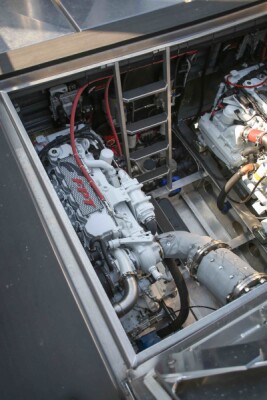
The FPTs turn ZF305 gears at 1.5:1 that drive Doen jets. “The guts are tough,” Aliotti says of the Australian-made jets. “The Doen has a heavier duty impeller, wear rings, sleeves, shaft, which means a lot less maintenance annually.”
Aliotti favors Pacific West refrigerated seawater – RSW – systems and put a hydraulic-powered 10-ton system in the Battleship. “The hold is divided into 13 sections that hold about 3,000 pounds each,” says Aliotti. “I have the RSW divided into four sections so they can chill down a little or a lot, depending.”
The Battleship’s deck layout is pretty standard for an Aliotti boat. “The stern roller is Kinematic. We make our own drums, very heavy duty. The drive is from SeaMar—Seattle Marine.” Seattle Marine also put together the hydraulic system for the Battleship. “Jordan Brooks and I installed it.”
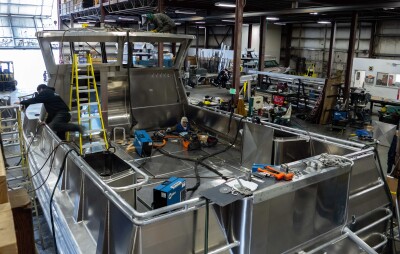
While supply chain issues have delayed many builders, the season for sockeye in Bristol Bay lasts only a few weeks, and if a boat isn’t finished on schedule, it can cost the owner a year’s earnings. “All the boats are looking for the same things, so I planned in advance,” says Aliotti. “I ordered what we needed way ahead of time.”
Components for the wheelhouse include a suite of electronics, with redundancy where it matters. “We have two Garmin GPSMAPs, with 12-inch displays, a 9-inch Garmin ECHOMAP, and a Garmin Fantom 18x radar,” says Aliotti. Other electronics include a Furuno SCX20 satellite compass, an a2004 Simrad autopilot, fusion stereo, and two Standard Horizon VHFs.
“We put a Starlink satellite dish on,” says Aliotti.
Crew comforts on the Battleship go with the motif. “It’s got a Norco refrigerator and freezer, and a stove,” says Aliotti. “We put a bathroom and a shower in one we built last year, but it cut down on space for the crew, so with the Battleship, we have an outside shower on deck with hot water. The bathroom is a bucket.
Heading North
When Justin Roeser dreamed up his mythology around the Battleship design, he envisioned a tough woman skipper. “She’s tough and street smart and knows how to catch fish and take care of her crew,” he says. The reality is not too far off. While the skipper is not a woman, most of the crew is.
“I think we have a great crew,” says Captain Derick Burns. “I got a guy I know, and he’s bringing two women who I haven’t met yet, but they’re all experienced. I only have one greenhorn, a young woman whose been helping me. I’m really looking forward to getting up there, catching fish, having fun, and coming home fat and happy.”
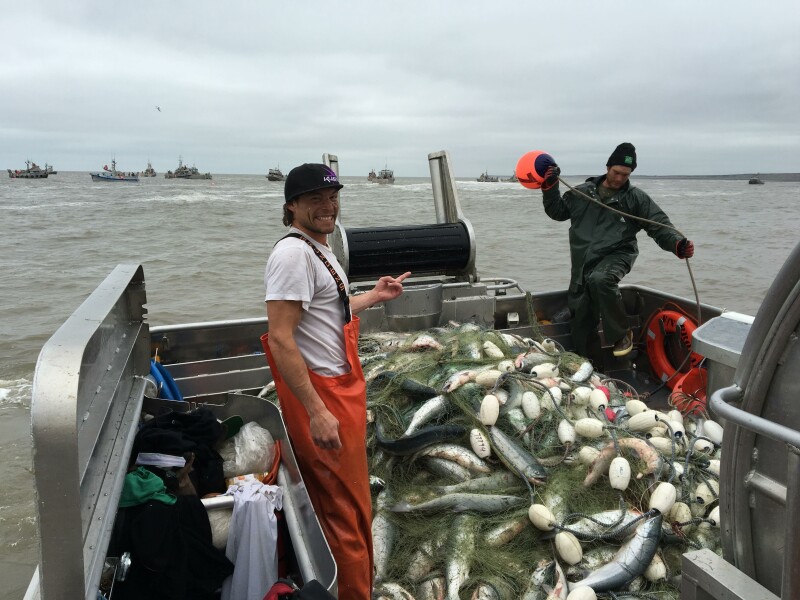
The Battleship has four bunks down forward, but Burns doesn’t expect them to get much use. “Last year, we had fish on deck, the net full of fish piled up in the stern—it was the season of no sleep—by the time we finished a delivery, another period would start. It was wild, just go. I was living disconnected from time.”
The 2023 sockeye harvest is expected to be 37 million fish, a good year, but far below the 60.1 million fish harvest of 2022. “I heard it was going to be a good season,” says Burns. “But I don’t get too worked up until I get there. Hopefully, we’ll pick the right spot and catch some fish.”
Burns started fishing with Aliotti around 2006 and has been running boats for him for about six or seven years, he guesses. “I feel really fortunate to have been able to run these amazing boats,” Burns says. “I helped build the first one, and they’ve come a long way. Being fishermen building boats we know what changes we want and know how to do into the making of them.”
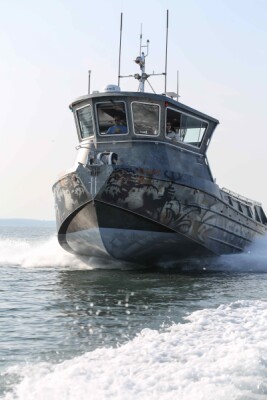
For the sea trials, Burns went along for the ride. “Tom ran the boat. It was a tight area, and the FPT guy with there with all kinds of monitors hooked to the engines, and we had to keep bumping the speed up by 100 rpms. By the end we were just ripping close to 40 knots, and it was kind of choppy so we were bouncing.”
Like Roeser and Aliotti, Burns is impressed with wrap. “Once it came out of the shop and into the water, you could see this beautiful green color in it that you couldn’t see before. It looks great.” On the practical side, Burns notes that the wrap protects the aluminum. “Usually aluminum boats start to get little white spots on them almost immediately, but with the wrap you don’t get that oxidation.”
According to Burns the boat will head north Nenek, Alaska on a tender. “We’ll fly into Naknek and then run the boat down to Egegik, which is where we fish out of.”
Between Roeser’s imagery of the Battleship and the mythology of its mostly women crew; the work Aliotti put into the design and construction; and Burns’s capable handling, the Battleship has a good chance of completing its mission. It will likely catch a lot of fish, sell some FPT engines, and spark people’s imaginations.
